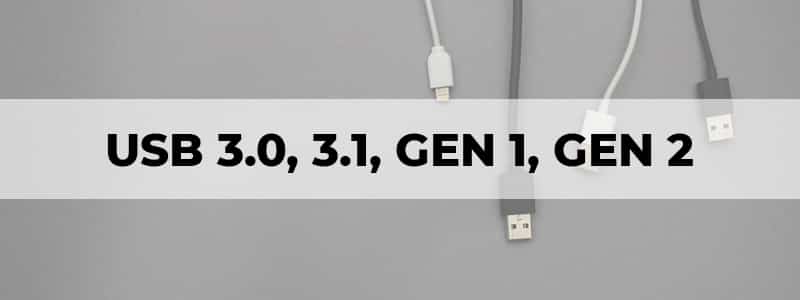
USBs (short for Universal Service Bus) have connected the whole world. Their popularity burgeoned them onto the global market a little over a decade ago when the introduction of the USB 3.0 made the technology accessible and extremely beneficial for personal and professional and use, as opposed to their previous incarnation which had very limited potential.
Today, the best flash drives are all of USB 3.0 and above, meaning USB 3.1 of USB 3.1 Type A, Type C, and so on. You’d be hard-pressed to find a good USB 2.0 that would do you any good.
What Is USB 3.0?
First presented to the world in 2010 after its availability being announced in 2008, the USB 3.0 upped the game for portable devices and data transfer and communication between various types of devices.
While even the USB 2.0 was the world’s most widely recognized interface for connectivity, today, the best USB hubs barely support USB 2.0 anymore, and for good reason.
With the way technology and the Internet have grown in the last decade alone, we now have tens of devices under each roof with multiple things needing connecting to multiple things for a single user, laser-fast speeds are required to facilitate quick and easy connection and sending of data between them.
The USB 3.0 transfer rate is impressive enough to fulfill all these modern world needs. While USB 2.0 boasted a bandwidth of 40MBps (definitely a step up from the 1.5/12MBps transfer rates of USB 1.0, for sub-channel and full-speed channels, respectively), the USB 3.0 has a bandwidth of 400MB per second or more.
As such, the USB 3.0 is also known as the SS USB, or, SuperSpeed. This transfer mode made the USB 3.0 transfer rate ten times faster than any USB mode before; up to 625MBps per second.
The USB 3.0 is distinguishable from the blue-tinged ports as well as SS initials on the ends of the cable.
USB 3.0 VS 3.1
Leveling up from the USB 3.0, a newer standard was introduced in July 2013. Dubbed the USB 3.1, featuring SuperSpeed+, this meant that the USB standard could now transfer up to 1.25GB per second owing to the USB 3.1 speeds.
This was superseded by the USB 3.2. Much like the infamous Star Wars prequels, each additional USB generational number that replaced its predecessors caused the naming conventions to be updated as well. All of the previous versions ultimately got to be known by reference to the USB 3.2.
How To Identify USB Naming Conventions
Under the USB 3.2, the USB 3.0 got to be known as the USB 3.2 Gen 1, and the USB 3.1 as USB 3.2 Gen 2. The actual USB 3.2 however, is then named the USB 3.2 Gen 2×2.
It might seem a little confusing, but they go in parallel and can be memorized or noted down quite easily. And, since they’re all SuperSpeed, they’re respectively called SuperSpeed USB, SuperSpeed USB 10GBps, and SuperSpeed USB 20GBps.
To put it in a form more easily seen:
- USB 3.0 / USB 3.2 Gen 1 / SuperSpeed USB
- USB 3.1 / USB 3.2 Gen 2 / SuperSpeed USB 10GBps
- USB 3.2 / USB 3.2 Gen 2×2 / SuperSpeed USB 20GBps
There’s also another confusion we’d delight in helping clear up. You see, the USB 3.1 had its own naming conventions… you’d hear perplexing things about the USB 3.1 Type A or the USB 3.1 Gen 2, and so on. The generations of the USB 3.1 are best and easier forgotten since older naming conventions are now outdated, but it’s helpful and interesting to know more about this system, nonetheless.
Finally, one of the most interesting discussions is of the pairing and understanding of USB 3.0 and USB Type C.
The USB Type C
At this point, you’d have heard a lot about Type C cables. It’s compact and it works well with all types of ports. What’s more – and truly amazing – is that it’s reversible and can be used either side up. It’s been hailed as a truly universal port and is being widely adopted by phones, mobiles, and laptops.
From what we’ve learned so far in this article, the question may arise: is a Type C USB SuperSpeed? USB 3.2 Gen 2×2? Or a new thing entirely?
It might be helpful to first understand Types A and B. Type A is the traditional, rectangular port that we’ve come to see, and Type B is the blockier, almost square one (and Type C is more like a rounded rectangle).
Since the various types of USB such as USB 3.0 and USB 3.1 are simply differentiations on the data transfer capability, we now have the understand to discuss merging USB types with the types of cables.
The most powerful combination thus far seems to be the USB 3.1 Type C. There’s a 100 watts of power available, four data lanes, meaning the ability to carry DisplayPort and HDMI signals, threatening to make propriety AC ports obsolete. The full potential of a USB Type C port is unleashed when it has Thunderbolt 3 capabilities. With a Thunderbolt 3 port, the USB Type C port is powerful enough to power an external GPU. Truly an amazing innovation.
